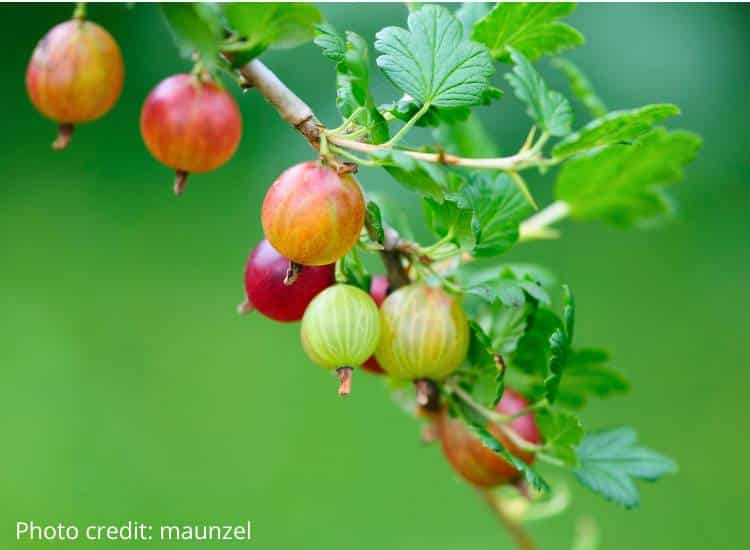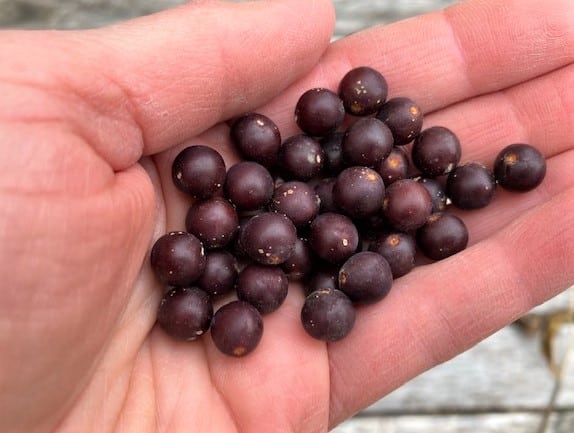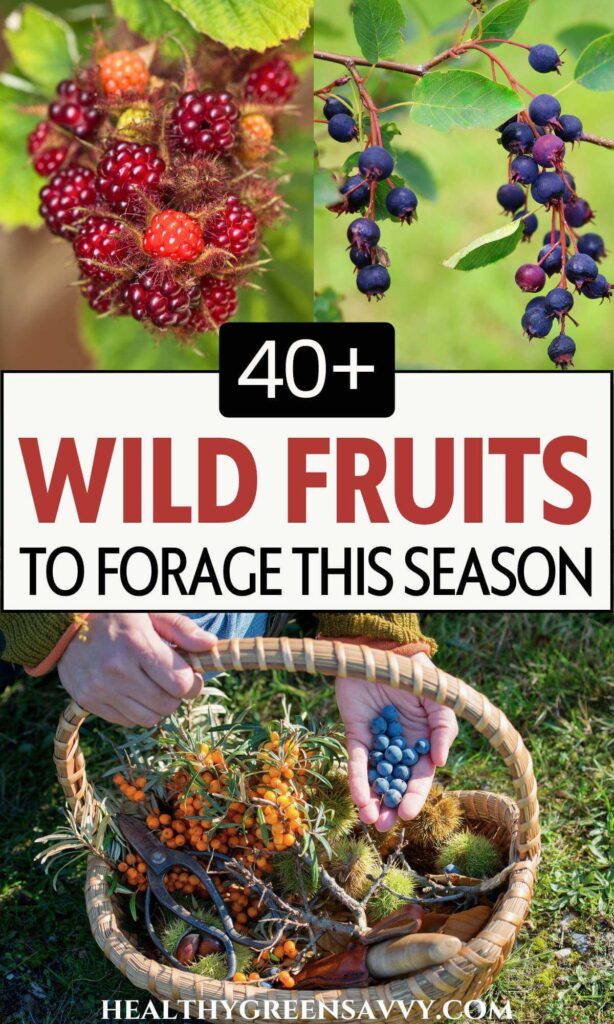Last Updated on October 23, 2024
Love to forage tasty wild plants? Here are more than 40 delicious wild fruits to seek out this season!

- FORAGING WILD FRUITS
- TOP WILD FRUITS TO FORAGE
- JUNEBERRIES / SERVICEBERRIES (AMELANCHIER SP.)
- MULBERRIES (MORUS SP.)
- WILD STRAWBERRIES (FRAGARIA VESCA)
- BLACK RASPBERRIES (RUBUS OCCIDENTALIS)
- WINEBERRIES (RUBUS PHOENICOLASIUS)
- SALMONBERRIES (RUBUS SPECTABILIS)
- THIMBLEBERRIES (RUBUS PARVIFLORUS)
- BLACKBERRIES (RUBUS SP.)
- BLUEBERRIES (VACCINIUM SP.)
- HUCKLEBERRIES (VACCINIUM AND GAYLUSSACIA SP.)
- WILD PLUMS (PRUNUS AMERICANA)
- GOOSEBERRIES (RIBES SP.)
- CURRANTS (RIBES SP.)
- WILD CHERRIES (PRUNUS AVIUM)
- ELDERBERRIES (SAMBUCUS CANADENSIS OR CERULEA)
- BLACK CHOKEBERRIES (ARONIA MELANOCARPA)
- PAWPAWS (ASUMINA TRILOBA)
- STRAWBERRY BLITE (BLITUM CAPITATUM)
- CHOKECHERRIES (PRUNUS VIRGINIANA)
- CRAB APPLES (MALUS SP.)
- HIGHBUSH CRANBERRIES (VIBURNUS TRILOBUM)
- TEABERRIES (GAULTHERIA PROCUMBENS)
- WILD GRAPES (VITIS SP.)
- LINGONBERRIES (VACCINIUM VITIS-IDAEA)
- BARBERRIES (BERBERIS VULGARIS)
- AUTUMN OLIVE (ELAEAGNUS UMBELLATA)
- HACKBERRIES (CELTIS OCCIDENTALIS)
- BEARBERRIES (ARCTOSTAPHYLOS UVA URSI)
- AMERICAN SPIKENARD (ARALIA RACEMOSA)
- ROSE HIPS (ROSA SP.)
FORAGING WILD FRUITS
Though you could buy all your fruit at the grocery store, foraging gives you access to a huge array of delicious wild fruits you won’t find in any supermarket.
Plus when you forage for wild plants, you get fresh air and exercise (plus all the health benefits of getting outside) as well as a deepened connection to the natural world. And all that yummy food is free!
Even better, wild fruits often pack more nutrients than their cultivated cousins. Wild plants add variety to our modern diets, which often don’t include a diverse array of health-promoting compounds called polyphenols.
While sometimes I’ll travel a few miles to forage wild berries and fruits, often I find that my own yard offers plenty of opportunities to gather loads of these delicious foraged treats. Though I did plant a lot of fruit myself, the birds have planted others, like our mulberry trees and the strawberry spinach that turned up last season.
SAFE FORAGING
Before you set off foraging, be sure to familiarize yourself with the fundamentals of safe foraging:
- Know your plants: Misidentifying a plant can be dangerous, even fatal. Use a reliable field guide (see below) and make absolutely sure you’ve positively identified any plant you intend to consume. When in doubt, don’t eat it.
- Sustainable foraging: Only take what you need, and leave enough for wildlife and plant regeneration. 10% of what’s there is a good guideline, unless it’s an invasive like garlic mustard. In such cases, pull up as much as you can!
- Mind the law: Some areas have regulations about foraging, especially in national and state parks. Check local guidelines to stay within the law and get permission if you want to forage on private property.
–> Be sure to consult a thorough and trustworthy foraging guide. THE best guide I’ve ever seen is Sam Thayer’s Field Guide to Edible Wild Plants. This comprehensive book covers of hundreds of edible wild plants and includes a novel system for identification. It’s on the heavy side because it covers so many plants, so you might explore additional foraging books that cover fewer plants and weigh less in your rucksack.
–> I’m not including plant identification details, as this post would be absurdly long. In some cases I link to plant ID posts. Always do your homework and read carefully about how to recognize these plants using multiple features before consuming.
Want to hone your plant identification skills? Herbal Academy offers numerous online courses in botany and foraging, as well as herbal medicine.
TOP WILD FRUITS TO FORAGE
With so many delicious wild fruits to choose from, how do you figure out where to start? I’m going to order this list by prioritizing the best-tasting fruits listed roughly in the order they appear through the season. At the end of the post you’ll find a list of additional fruits to explore.
If you’re newer to foraging, check out the best wild edible plants for beginners, which include some of the wild fruits below.
JUNEBERRIES / SERVICEBERRIES (AMELANCHIER SP.)

I’m putting juneberries (saskatoons to you Canadian readers) at the very top of this list, because they are abundant, easy to find, and absolutely delicious.
They’re also some of the first wild fruits to forage, ready in June, hence the common name ‘juneberry.’
Best of all, they’re a popular landscaping tree or shrub, so you’ll often find them planted as street trees or in other ornamental landscapes.
Here’s more about foraging juneberries, and here’s a collection of serviceberry recipes if you find yourself with a surplus. They don’t keep long, so eat any you want fresh, then freeze them or use them in your favorite recipes.
Juneberries look a lot like blueberries but taste even better, with a hint of almond. Serviceberries grow on shrubs and small trees across North America, ripening in early summer. They are excellent eaten fresh, baked into pies, or dried for a sweet snack. Their beautiful white flowers in spring are also a lovely bonus for foragers.
, are sweet and nutty. These purple berries grow on shrubs and small trees, ripening in early summer. They’re fantastic in pies, muffins, and even as a dried snack. Their high fiber content makes them a healthy choice for foragers.
MULBERRIES (MORUS SP.)

Mulberries come in black, red, and white varieties, each with a unique flavor. These berries grow on trees and ripen in early to midsummer. They are extremely juicy and can stain your hands, but their sweet flavor is worth it. Try them in pies, smoothies, or just eat them fresh by the handful.
Here’s more about identifying mulberries. Check out this collection of mulberry recipes and enjoy them in all sorts of inventive ways,
WILD STRAWBERRIES (FRAGARIA VESCA)

Wild strawberries are very small compared to your average grocery store strawberry, but they’re also sweeter and far more flavorful. You’ll typically find them in sunny meadows and forest edges from spring to early summer.
A very similar plant, the alpine strawberry, is commonly sold in garden centers if you’d like to try growing some of these tasty fruits in your edible landscape.
BLACK RASPBERRIES (RUBUS OCCIDENTALIS)

Often mistaken for blackberries, wild black raspberries (sometimes called blackcaps or black cap raspberries) grow in eastern North America. They grow on arching canes in woodland edges and fields, ripening from June to July. Enjoy them fresh, baked in muffins or made into homemade preserves. They’re on the seedy side, so save this flavorful spread for someone who enjoys seedy jams.
Learn more about identifying wild black raspberries.
Different parts of the country have other species of wild raspberries to explore. Find out more about these regional options below.
WINEBERRIES (RUBUS PHOENICOLASIUS)

Wineberries are a prolific relative of raspberries that flourish in the mid-Atlantic states. Considered an invasive, wineberries’ dense thickets can crowd out native species. You’re doing the habitat a favor by gathering as many as you can!
SALMONBERRIES (RUBUS SPECTABILIS)
Salmonberries grow in the Northwest. Their color ranges from orange to red, and they have a mild, slightly tart flavor. Look for them in moist, shady areas in late spring and early summer. These berries are great for snacking on trails or adding a unique twist to your jams and jellies.
THIMBLEBERRIES (RUBUS PARVIFLORUS)
Thimbleberries grow in western North America as well as around the Great Lakes. They grow on shrubby plants in forest clearings and edges and are ready in midsummer. They’re delicate and best enjoyed fresh, right off the plant.
BLACKBERRIES (RUBUS SP.)
Blackberries are larger and juicier than black raspberries, with a tart-sweet flavor. They grow on thorny canes in fields and forest edges, ripening in midsummer. These versatile berries can be used in everything from pies to salads. They’re also high in fiber and vitamin C.
BLUEBERRIES (VACCINIUM SP.)
Wild blueberries are smaller but more flavorful than cultivated ones. They grow in acidic soils in forests and open areas, ripening from midsummer to early fall. These antioxidant-rich berries are perfect for baking or eating fresh. They’re also a popular ingredient in traditional native dishes.
HUCKLEBERRIES (VACCINIUM AND GAYLUSSACIA SP.)
Huckleberries look like blueberries but have a more intense flavor. You can find them in northern latitudes in late summer. They don’t grow in my area, but you can learn more about them from the International Wild Huckleberry Association if you’re curious. Also known as bilberry or whortleberry, they’re often used in desserts and preserves.
Bears are also fond of huckleberries, so keep an eye out while you’re foraging!
WILD PLUMS (PRUNUS AMERICANA)

Wild plums grow on small trees in thickets and along riverbanks, ready for picking in late summer. These plums can be used in a variety of recipes, from sauces to desserts. On a recent plant walk I took, the local foraging expert leading the class pronounced wild plums his all-time favorite wild fruit of summer.
Beach Plums (Prunus maritima) are tart but make excellent jams and jellies. They grow on low shrubs along the East Coast, ripening in late summer. These hardy plants thrive in sandy soils and are resistant to salt spray. Beach plums are also used to make a traditional East Coast jelly.
GOOSEBERRIES (RIBES SP.)

Gooseberries have fallen out of fashion, but they were a staple fruit a century ago. I grew some in my tiny yard for many years, before I decided that their rangy-looking, thorn-covered stems just weren’t going to make the cut for our front-yard edible landscape. Their plentiful mild fruits were fun to have, though!
Fortunately, they grow wild in the woods near my house. They’re quite shade-tolerant, so you might find them in forests on your next hike. Watch out for their sharp thorns. They can be tart or sweet and ripen mid to late summer. You can eat them fresh or use them in either sweet or savory dishes.
CURRANTS (RIBES SP.)
Currants can be red, black, or white, each with a distinct flavor. They grow on shrubs in forests and open areas and are generally ready for harvest in midsummer. Black currants have a rich flavor that makes them great for fresh eating, baking, jellies, and wines. Black currant juice is great splashed in seltzer for a refreshing summer spritzer.
WILD CHERRIES (PRUNUS AVIUM)
Wild cherries are small but pack a lot of flavor. They grow on large trees and ripen in late spring to early summer. While they’re a bit tart to eat fresh, they’re excellent for making jams and syrups. Birds love them too, so you’ll have to be quick to get your share.
ELDERBERRIES (SAMBUCUS CANADENSIS OR CERULEA)

Elderberries are fun to forage and provide you with flavorful medicine to see you through the winter. I spent a year researching elderberries for my book, Everything Elderberry, and learned a ton about using these delicious and valuable fruits. Here’s one of the most comprehensive guides to elderberry identification you’ll find on the web.
Harvest elderberries from late summer to early fall. Berries ripen unevenly, and plants growing in shade will have ripe berries later than those growing in sun. Unlike many other wild berries, elderberries should be cooked to avoid stomach upset. There’s some confusion about their safety profile, so read the post ‘Are Elderberries Poisonous?’ for clarification. You can also pick up our free guide to using elderberries safely here.
In addition to their wonderful flavor, elderberries have gained popularity for their ability to fight viruses and support the immune system. You can put them in baked goods or use them to make immune boosting elderberry syrup, long-lasting tinctures, elderberry tea, and lots more.
Here are more than 20 uses for elderberries to try if you find yourself with a big haul.
BLACK CHOKEBERRIES (ARONIA MELANOCARPA)

Don’t be put off by this berry’s common name! Indeed, if you eat it right off the bush at the wrong time, you won’t love it, but picked at the right time or simmered with sweetener, aronia berries are an excellent wild fruit to know.
Like many other dark purple fruits (such as elderberries and mulberries), aronia is exceptionally rich in antioxidants called anthocyanins.
Here’s how to identify black chokeberry. If you need ideas for using them, check out our collection of aronia berry recipes.
PAWPAWS (ASUMINA TRILOBA)
Pawpaws are North America’s largest native fruit. They taste like a mix of banana and mango and grow in shady, moist areas. They ripen in late summer. They have a custard-like texture that makes them perfect for desserts.
STRAWBERRY BLITE (BLITUM CAPITATUM)

Strawberry blite is a fun wild plant to know, though its plentiful little red fruits are not the most flavorful you’ll find. They’re mildly sweet and without a lot of flavor, but the leaves of the plant they grow on are stellar, even when other wild greens have gotten bitter in midsummer.
Find out more about identifying strawberry blite.
CHOKECHERRIES (PRUNUS VIRGINIANA)
Chokecherries are tart and astringent but can be great in jellies and wines. They grow in clusters on small trees or shrubs and ripen in late summer. While too sour to eat fresh, their high pectin content makes them perfect for preserves. Just be sure to remove the pits, as they are not edible.
CRAB APPLES (MALUS SP.)

Crab apples are on the tart side, but they make great jellies and sauces. Some larger types can be good for fresh eating, especially if you enjoy tarter apples.
These small apples grow on trees in a variety of habitats, ripening in late summer to fall. They’re high in pectin, making them ideal for setting jams and jellies.
Some crab apples taste much better than others, and generally the smallest are the most bitter. Find out more as well as many uses for crab apples.
HIGHBUSH CRANBERRIES (VIBURNUS TRILOBUM)
Despite the name, highbush cranberries aren’t true cranberries. They’re tart and make excellent sauces and jellies. Look for them in wetlands and forest edges in late summer to early fall. These berries are also a favorite among wildlife, so you might have to compete with birds for your share.
TEABERRIES (GAULTHERIA PROCUMBENS)
These bright red berries taste like wintergreen chewing gum. They grow on low shrubs in pine forests and are best harvested in fall and winter. Their unique flavor makes them a fun addition to desserts and teas. Wintergreen leaves can also be used to make a refreshing tea.
WILD GRAPES (VITIS SP.)
Wild grapes are smaller and tarter than cultivated ones but great for juices and jellies. They grow on vines in forests and along riverbanks, ripening in late summer to fall. Their high acidity makes them perfect for making wines and preserves. Wild grapes are also a good source of vitamins A and C.
LINGONBERRIES (VACCINIUM VITIS-IDAEA)
Lingonberries are tart and tangy, perfect for sauces and preserves. They grow on low shrubs in northern forests, ready for harvest in late summer. These berries are a staple in Scandinavian cuisine, often served with meat dishes. Lingonberries are also rich in antioxidants and vitamins.
BARBERRIES (BERBERIS VULGARIS)
Barberries are small, tart red berries often used in Middle Eastern cuisine. They grow on thorny bushes and ripen in late summer to fall. These berries are rich in vitamin C and add a nice tang to dishes. Be mindful of the thorns when harvesting.
AUTUMN OLIVE (ELAEAGNUS UMBELLATA)
Autumn olives are small, red berries with a sweet-tart flavor. They grow on shrubs that can be found in open fields and along roadsides, ripening in the fall. These berries are packed with lycopene, an antioxidant, making them a nutritious snack. Their silver-speckled appearance makes them easy to identify.
HACKBERRIES (CELTIS OCCIDENTALIS)

Hackberries are small, sweet fruits that grow on hackberry trees. They have a date-like outer layer surrounding a hard but edible center. They’re a good source of calories when other wild foods are hard to come by.
They ripen in fall, often persisting into winter. These berries are great for snacking or adding to cereals and baked goods. The trees are common in both urban and rural areas, making them easy to find.
Learn more about identifying and using hackberry fruits.
BEARBERRIES (ARCTOSTAPHYLOS UVA URSI)

Bearberries are small, red berries that grow on low growing shrubs in northern regions. They ripen in late summer and fall. Bearberries are quite tart and are most often used in jams and preserves.
Bearberries are also known for their medicinal properties and have been used in traditional medicine.
The leaves of bearberry plants have a long history of medicinal use, making them one of many attractive groundcover herbs to consider growing in your yard.
AMERICAN SPIKENARD (ARALIA RACEMOSA)

American spikenard is a somewhat unusual plant that can look a lot like elderberries. Spikenard produces little bunches of flavorful berries that can be used in jam, wine, or infused liqueurs. They’re mildly sweet with a note of pine that’s much more pronounced on unripe berries.
A related plant known as wild sarsparilla (Aralia nudicaulis) is sometimes called small spikenard, and false Solomon’s seal (Maianthemum racemosum) sometimes gets called ‘false spikenard.’ Both also have edible berries, though.
Find out more about foraging and using American spikenard.
ROSE HIPS (ROSA SP.)

Rose hips are the fruit of wild rose bushes and ripen in late summer to fall. They’re a popular herbal ingredient for their vitamin C content and can be used to make teas, jellies, and syrups. They contain some pectin and work as a thickener for homemade elderberry syrup.
Like other members of the rose family, they have seeds you want to avoid eating. If you’re simmering them for tea, syrup, or jelly, it’s fine to leave the seed, but if you want to eat the fruit, you’ll want to be sure to remove all seeds and hairs.
Want additional wild fruits to consider? Here are a bunch more!
- Buffalo berries
- Bunchberry
- Cloudberry
- Cranberry
- Dewberry
- Groundcherry
- Hawthorn berry (a highly-regarded medicinal berry, better made into tea or tincture)
- Manzanita berry
- Nannyberry
- Partridgeberry
- Pin cherry
- Prickly pear
- Rowan berry (the fruit of the mountain ash tree, not tasty until processed!)
- Sea buckthorn
- Solomon’s plume (not Solomon’s seal)
If there’s something you like to forage that’s not on this list, please leave a comment and I’ll try to add it!
Save this info on edible wild fruits for later!

Additional photo credits: Cover — Oksana Alekseeva, Avalon_Studio, maunzel, GoranH ; pin — StudioBarcelona, np-e07, ananaline
Disclaimers: Though HealthyGreenSavvy and EcoSavvy Writing LLC always aim to provide thorough and accurate information, we assume no liability or responsibility for any consequences, health issues, or symptoms that arise from ingesting or touching any plant described on this website. It is always the reader’s responsibility to ensure accurate plant identification and use multiple reputable sources to confirm. If you have any doubts about the identification of any plant, do not eat it.

Susannah is a health and environmental writer focusing on gardening, foraging, medicinal plants, and sustainability. Her work has appeared in Mother Earth Living, Ensia, Northern Gardener, Sierra, and on numerous websites. Her first book, Everything Elderberry, released in September 2020 and was a #1 new release in holistic medicine, naturopathy, herb gardening, and other categories. Find out more and grab your copy here.




 Hi, I'm Susannah, a garden geek, energy nerd, and fan of healthy food and natural remedies. Need some simple, practical solutions for living healthier and greener? You've come to the right place! More about me and my green projects
Hi, I'm Susannah, a garden geek, energy nerd, and fan of healthy food and natural remedies. Need some simple, practical solutions for living healthier and greener? You've come to the right place! More about me and my green projects
Leave a Reply